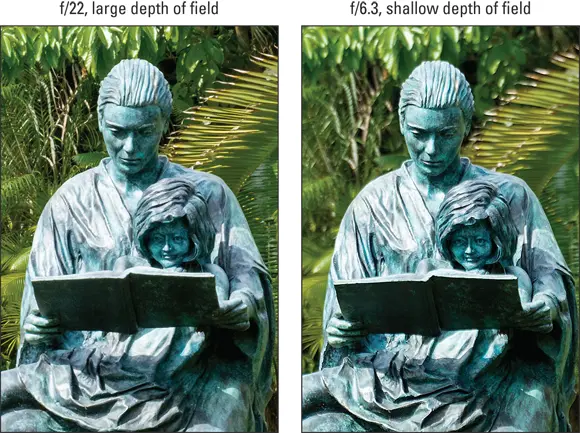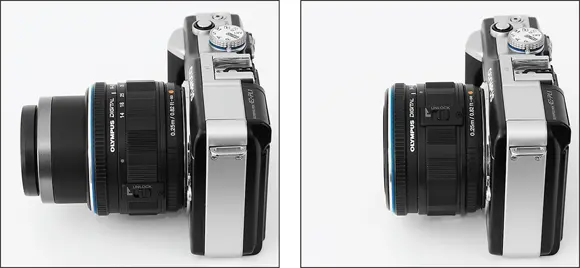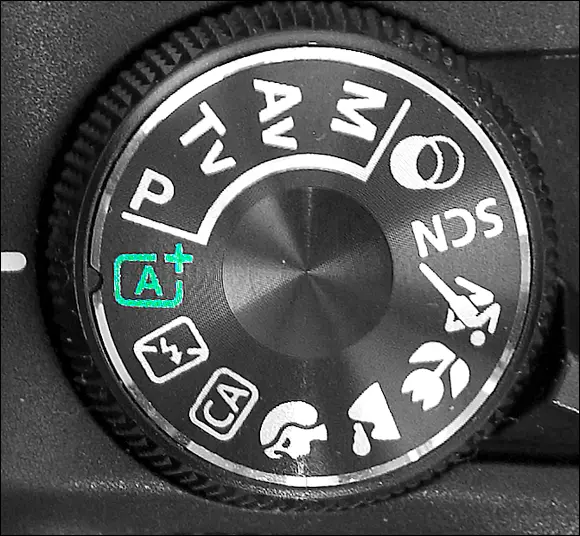
FIGURE 1-10:For the left image, I set the aperture to f/22; for the right image, f/6.3.
And why, you're probably wondering, is the exposure of both images in Figure 1-10 the same, given what I just said about the f-stop affecting image brightness? This is why: To compensate for opening the aperture to f/6.3, I reduced the exposure time by changing the shutter speed from 1/320 of a second to 1/4000 of a second, so the light was able to strike the image sensor for a shorter period. I kept the ISO setting (light sensitivity) at ISO 400 for both photos.
You can explore f-stops, exposure, and depth of field further in Part 2of the book. For the purpose of comparing lenses, you need just a few more bits of aperture information:
Every lens has a specific range of aperture settings. Obviously, the larger that range, the more control you have as a photographer.
The larger the maximum aperture, the “faster” the lens. Again, the more open the aperture becomes, the less time is needed to expose the image. So if one lens can open to a maximum setting of f/4 and another lens has a maximum aperture of f/2, the f/2 version is said to be faster. A fast lens is especially beneficial when photographing action, because a moving subject blurs at long exposure times. But it also helps when you shoot in dim lighting, because you can get the shot at a lower ISO setting, reducing the chances of image noise. That very low f-stop also enables you to produce images that have a very shallow depth of field when your creative vision demands it.
On a zoom lens, the aperture range may change as you zoom in or out. For example, on an 18–140mm lens, you may be able to open the aperture to f/2 when the lens is at the 18mm position but only to f/5.6 at 140mm. You can buy zoom lenses that maintain the same minimum and maximum apertures throughout the zoom range, but be prepared to part with more money than for a lens that doesn't offer this feature.
Depth of field at any aperture varies depending on the size of the image sensor and lens. Cameras with small sensors and lenses produce a much greater depth of field at any f-stop than cameras with larger sensors and lenses. The result is that it can be difficult to achieve much background blurring even if you open the aperture all the way. That's an important consideration if you're interested in the type of photography that benefits from a short depth of field, such as portraiture. On the other hand, if you're a landscape photographer, you may love the extended depth of field those smaller sensors and lenses produce.
Minimum focusing distance
This number is especially important if you enjoy shooting close-ups. The shorter the minimum focusing distance, the closer you can get to your subject, enabling you to fill the frame with small details.
 If you're really into close-up photography, you may want a macro lens, which permits especially close focusing. Technically, the term macro means that the lens can record an object at its actual size or larger, but sometimes the label is used to refer to closer-than-normal focusing in general. Check out Chapter 10for more tips on close-up photography.
If you're really into close-up photography, you may want a macro lens, which permits especially close focusing. Technically, the term macro means that the lens can record an object at its actual size or larger, but sometimes the label is used to refer to closer-than-normal focusing in general. Check out Chapter 10for more tips on close-up photography.
Today's lenses are significantly lighter and smaller than those from even a few years ago. So if you're shooting with an older lens that's weighing you down — literally — check out the newer options. Some lenses retract into a more compact form when you're not using them, as shown in Figure 1-11.
 For a super-zoom lens, look for a model that has a lens-lock feature. The lock holds the lens in its “unzoomed” position when you’re not using the camera. Without the lock, the lens may be subject to lens creep, which means that the lens extends under its own weight when the camera is pointed down, such as when it’s on a traditional camera strap, hanging around your neck.
For a super-zoom lens, look for a model that has a lens-lock feature. The lock holds the lens in its “unzoomed” position when you’re not using the camera. Without the lock, the lens may be subject to lens creep, which means that the lens extends under its own weight when the camera is pointed down, such as when it’s on a traditional camera strap, hanging around your neck.

FIGURE 1-11:Some lenses collapse when not in use, taking up less room in your camera bag.
Last but most definitely not least, two lenses with the exact same size and aperture specifications may not be equivalent in terms of the quality of the components used to manufacture them. As stated earlier, the best way to get information on this issue is to read reviews from independent photography magazines and websites. If you already own a camera body and are just shopping for a new lens, you may also be able to visit a camera store and take some test shots with different lenses.
SO HOW MUCH IS THIS GOING TO COST?
Camera prices are dynamic, so any dollar amount I mention will likely be out of date by the time you read this. But as a general guideline, basic cameras range from about $75 to $200, and intermediate-level models sell in the neighborhood of $300 to $800. Advanced models typically set you back around $800 to $2,000 or even higher, and that price may or may not include a lens. Lenses also vary widely in price, starting at around $150 and reaching into the thousands.
Note that these price guidelines don’t include smart device cameras. Prices for phones and tablets are based on far more than the camera capability, although the photography-fun aspect of such devices seems to be the one most touted in ads. Again, check reviews to get the scoop on how various devices stack up in terms of camera performance.
Remember, too, to include a few necessary accessories in your budget, such as memory cards (the little cards that store your pictures), a tripod, and a good camera bag. See Chapter 6for information about flash and lighting accessories; Chapter 8for portrait-photography accessories; and Chapter 10for some landscape-photography tools. Chapter 14covers additional accessories to consider.
Lens quality isn’t just about the purity of the image produced, though; things like how smoothly a telephoto lens extends and whether the lens feels solid or flimsy are also important. If you’re an outdoor photographer, a weather-sealed lens may also be important to you.
Reviewing a Few Final Camera Features
I could write an entire book decoding all the other specifications that affect the type and quality of the pictures your camera can produce. But we'd both be bored to tears after the first few pages. Instead, the rest of this chapter lists only the options that I think make a real difference. Some are designed just to make things easier for beginners, some are geared to advanced photographers, and some can improve your time behind the lens no matter what your experience or interest level.
How much artistic control a camera offers is closely tied to its choice of shooting modes, sometimes called exposure modes. Usually, shooting modes are represented by letters and symbols like the ones you see on the camera dial in Figure 1-12.

FIGURE 1-12:The various symbols on this camera dial represent shooting modes.
Читать дальше


 If you're really into close-up photography, you may want a macro lens, which permits especially close focusing. Technically, the term macro means that the lens can record an object at its actual size or larger, but sometimes the label is used to refer to closer-than-normal focusing in general. Check out Chapter 10for more tips on close-up photography.
If you're really into close-up photography, you may want a macro lens, which permits especially close focusing. Technically, the term macro means that the lens can record an object at its actual size or larger, but sometimes the label is used to refer to closer-than-normal focusing in general. Check out Chapter 10for more tips on close-up photography.












